Zetta Elliott's Blog, page 42
October 22, 2015
tall trees
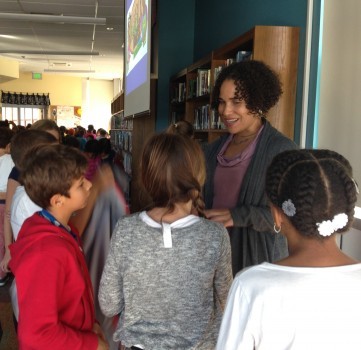 I spent the first half of this week in Berkeley, CA but this morning when asked why I’d gone out west (business or pleasure?) I couldn’t find words to describe my trip. With some friends, it doesn’t matter how much time has passed. When you get together again, the words just flow and that’s how it is whenever I see Laura Atkins. She graciously opened her home to me and we spent Monday just catching up. Her daughter baked me an amazing birthday cake and I plucked off all the sweet tarts over the course of my three-day stay. Laura coordinated a school visit for me and so I gave two talks at Jefferson Elementary School on Tuesday morning. I was thrilled to share Maya Gonzalez and Matthew Smith’s new initiative through Reflection Press: Write Now! Make Books. It’s got everything kids (and grownups) need to learn how to turn their story ideas into a book—check it out! After my school visit we convened at Janine’s lovely
I spent the first half of this week in Berkeley, CA but this morning when asked why I’d gone out west (business or pleasure?) I couldn’t find words to describe my trip. With some friends, it doesn’t matter how much time has passed. When you get together again, the words just flow and that’s how it is whenever I see Laura Atkins. She graciously opened her home to me and we spent Monday just catching up. Her daughter baked me an amazing birthday cake and I plucked off all the sweet tarts over the course of my three-day stay. Laura coordinated a school visit for me and so I gave two talks at Jefferson Elementary School on Tuesday morning. I was thrilled to share Maya Gonzalez and Matthew Smith’s new initiative through Reflection Press: Write Now! Make Books. It’s got everything kids (and grownups) need to learn how to turn their story ideas into a book—check it out! After my school visit we convened at Janine’s lovely 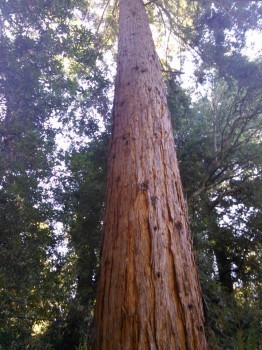 home in the Oakland foothills and set our agenda for that evening’s kid lit mixer. It was a wonderful gathering and an important conversation between radical kid lit creators, librarians, and literacy activists (more on that later). I’ve got jet lag and need to turn in so I can get to tomorrow’s morning school visit on time, but I wanted to at least try to explain why I went to California this week. Next week it’s London (for pleasure) and the week after that I’ll be in Arkansas (for business), but trips often blur that line. I enjoy doing research for my book projects and I love meeting students and educators wherever I go. I went to CA because my group of rad kid lit creators agreed that we needed some face time; we have monthly video conferences and we “see” each other online, but it’s not the same as being in the same room as we laugh, and debate, and explore our vision for the future of children’s literature. We shared our latest projects, and we ate delicious food, and we followed a narrow path up a steep hill that was lined with towering redwood trees. I once heard a fellow expat say, “In Canada, they trim the tallest trees.” No one is encouraged to reach for the sky because standing out, rising above your peers is frowned upon. And maybe that kind of individualism isn’t good for the community, but when you’re small small or young or simply uncertain, seeing the unlimited potential of those around you is necessary. The more my friends achieve, the more I feel I’m able to try—my daring and theirs are bound together. You can tell just from the looks on our faces how much it meant to be together for three days—and we’re already planning the next retreat! Time for bed—I’ll try to write about the mixer tomorrow…
home in the Oakland foothills and set our agenda for that evening’s kid lit mixer. It was a wonderful gathering and an important conversation between radical kid lit creators, librarians, and literacy activists (more on that later). I’ve got jet lag and need to turn in so I can get to tomorrow’s morning school visit on time, but I wanted to at least try to explain why I went to California this week. Next week it’s London (for pleasure) and the week after that I’ll be in Arkansas (for business), but trips often blur that line. I enjoy doing research for my book projects and I love meeting students and educators wherever I go. I went to CA because my group of rad kid lit creators agreed that we needed some face time; we have monthly video conferences and we “see” each other online, but it’s not the same as being in the same room as we laugh, and debate, and explore our vision for the future of children’s literature. We shared our latest projects, and we ate delicious food, and we followed a narrow path up a steep hill that was lined with towering redwood trees. I once heard a fellow expat say, “In Canada, they trim the tallest trees.” No one is encouraged to reach for the sky because standing out, rising above your peers is frowned upon. And maybe that kind of individualism isn’t good for the community, but when you’re small small or young or simply uncertain, seeing the unlimited potential of those around you is necessary. The more my friends achieve, the more I feel I’m able to try—my daring and theirs are bound together. You can tell just from the looks on our faces how much it meant to be together for three days—and we’re already planning the next retreat! Time for bed—I’ll try to write about the mixer tomorrow…
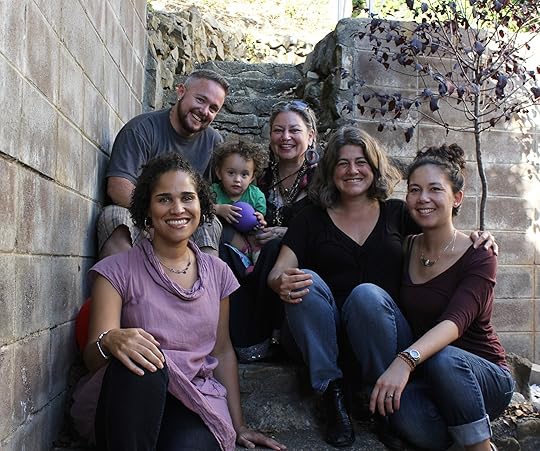
Janine used a timer to capture this great photo in her backyard. Clockwise: me, Matthew Smith, Sky, Maya Gonzalez, Laura Atkins, & Janine Macbeth.
October 10, 2015
Intersectionalty & positionality
I woke at 4am this morning knowing I had to be up soon to catch my 7am train to Baltimore. This cold seemed to be over—I made it through yesterday without sneezing once—but today I woke with an impossible headache and by the time my meds kicked in, I’d missed my train. I sent my presentation to the Kidlitcon coordinators and my co-panelist Mary Fan read my remarks for me. I figured I’d post my remarks here and when the video is posted, I’ll share that, too, so you can hear what the other panelists had to say. Not the way I thought this day would go…
Intersectionality: The Next Step in Diverse Books
Good morning! My name is Zetta Elliott and I will be moderating the next panel. I’ll start with brief introductions and then I’ll take a moment to define some key terms.
Mary Fan is a sci-fi/fantasy author, first-generation American, lifelong nerd, advocate for women in tech, and nobody’s Asian trophy wife.
Dynamic twin bloggers and debut authors: Guinevere and Libertad Thomas of Twinja Book Reviews create and critique diverse speculative fiction for teens; their debut novel is The Mark of Noba.
And I’m a middle-aged author, educator, scholar, immigrant, self-publisher, and fierce Black feminist advocate for greater diversity AND equity in kid lit.
We live in an either/or world that prefers to put people into simple, separate boxes. But identity is fluid, not fixed and books can help to reveal just how rich and complex our identities really are.
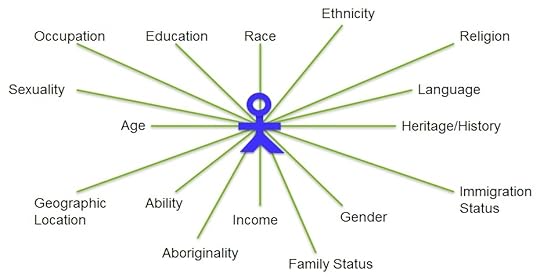
Source: Canadian Research Institute for the Advancement of Women
Understanding intersectionality begins by examining one’s own identity. Privilege has enabled many in the dominant group(s) to avoid considering the multiple ways in which individuals can experience—and perpetuate—oppression. At the same time, the preference for “single-issue books” can limit an author’s ability to explore/expose the various, overlapping systems that create the unfair advantages and disadvantages that shape our lives.
This graphic from the Canadian Research Institute for the Advancement of Women shows how each individual exists at the intersection of multiple aspects of identity. The opportunities available to us in this society can be enhanced and/or limited by one or multiple aspects of our identities. The experience of advantage or disadvantage can change from moment to moment—CONTEXT COUNTS.
I found this great definition of intersectionality on the site Geek Feminism Wiki:
Intersectionality is a concept often used in critical theories to describe the ways in which oppressive institutions (racism, sexism, homophobia, transphobia, ableism, xenophobia, classism, etc.) are interconnected and cannot be examined separately from one another. The concept first came from legal scholar Kimberlé Crenshaw in 1989 and is largely used in critical theories, especially Feminist theory, when discussing systematic oppression. When possible, credit Kimberlé Crenshaw for coining the term “intersectionality” and bringing the concept to wider attention.
 Intersectionality has become more widely known and used in recent years, but many people fail to acknowledge the critical role played by Black feminists like Sojourner Truth (who asked “Ain’t I a woman?” back in 1851), Audre Lorde, and legal scholar Kimberlé Crenshaw who coined the term in a seminal 1989 essay, “Demarginalizing the Intersection of Race and Sex: A Black Feminist Critique of Antidiscrimination Doctrine, Feminist Theory and Antiracist Politics.”
Intersectionality has become more widely known and used in recent years, but many people fail to acknowledge the critical role played by Black feminists like Sojourner Truth (who asked “Ain’t I a woman?” back in 1851), Audre Lorde, and legal scholar Kimberlé Crenshaw who coined the term in a seminal 1989 essay, “Demarginalizing the Intersection of Race and Sex: A Black Feminist Critique of Antidiscrimination Doctrine, Feminist Theory and Antiracist Politics.”

Image credit: Time Out London
You may have heard the term intersectionality used quite frequently as of late as white feminists reveal that the blindspots they had over a century ago persist to this day. Case in point: the publicity campaign for the forthcoming film Suffragette. The all-white cast posed in t-shirts bearing a quote first made my Emmeline Pankhurst in 1903—it was offensive then, and it’s offensive today. Black women actually WERE slaves, and rebellion isn’t merely a choice made by the righteous. The film focuses exclusively on white women in England even though women around the world also fought for the right to vote—and didn’t get it until long after their white “sisters” did.
When you’re driving, you can’t simply rely upon your car’s rear-view or side-view mirrors to keep you and others safe on the road. You have to look over your shoulder before you change lanes. One way to correct your blindspots when it comes to identity is to always situate yourself in relation to a text—state your particular position so that it’s clear and not allowed to operate invisibly as neutrality.
When you’re reading or reviewing a book, it’s important to publicly locate yourself—state your position because aspects of your identity will impact the way you engage with the text. There’s no such thing as an “average” or “objective” reader (or writer). I found this definition of positionality useful:
“By positionality we mean…that gender, race, class and other aspects of our identities are markers of relational positions rather than essential qualities. Knowledge is valid when it includes an acknowledgment of the knower’s specific position in any context, because changing contextual and relational factors are crucial for defining identities and our knowledge in any given situation.”
In our society, there is a default setting that privileges certain people. If I say, “Look at that doctor!” the default setting teaches us to expect a white, straight, middle- to upper middle-class man, probably middle-aged or older, wearing a white lab coat. If I say, “Look at that woman doctor!” the default has been manually adjusted in terms of gender, but all the other “settings” remain the same.
We ALL have blindspots. Did you catch mine? A while back (during the highly publicized transition of Caitlyn Jenner) I offended a dear friend by posting an article on Facebook that said some reactionary things about transwomen. When she questioned my decision to post it, I responded defensively, insisting “A lot of women are feeling anxious right now.” I should have said, “A lot of cis-gender women are feeling anxious right now” because that’s the position I was speaking from and it acknowledges the perspective of transwomen (which might be different).
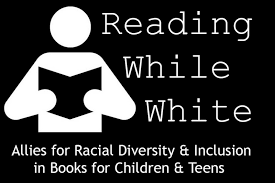 Please read this blog. Every single post. Here’s how contributor Allie Jane Bruce came to an understanding of intersectionality by positioning herself in relation to others:
Please read this blog. Every single post. Here’s how contributor Allie Jane Bruce came to an understanding of intersectionality by positioning herself in relation to others:
Over the next few weeks–months–years, I gradually became aware of a world of exemptions, of -isms I’ve never had to deal with. I am a woman, yes. I am also White, heterosexual, cisgender, and not disabled. I am a documented citizen, I am housed, I am educated. None of these things change the fact that as a woman, I experience sexism (as it manifests against white women). But similarly, my woman-ness doesn’t alter the truth that I belong to the dominant group along these and many other identifiers.
I decided this past year to stop sending my books out for review. Only 2% of published children’s book authors in the US are Black, and after struggling for over a decade to sell my many manuscripts, I finally decided to self-publish. I was thrilled when the Reading While White blog appeared; I consider many of the contributors friends and allies, and I know that white women will NEVER listen to me the same way they will listen to another white woman.
I operate in fields that are dominated by white women—whether I’m dealing with a school, a library, a publisher, or a nonprofit, I will likely have to deal with a white woman gatekeeper who isn’t from my community, doesn’t know much about my culture, and yet has a lot more power than me. The same is true when it comes to reviewers. It’s not enough just to read diverse books. Marginalized writers need members of the dominant group(s) to acknowledge their advantages and the role their GROUP has played in creating and maintaining disparities. Do start with the woman in the mirror—but then join those who are committed to equity and not only diversity.
October 9, 2015
Independent Sources
Dayshaun’s Gift blends history, magic, and social commentary.
October 7, 2015
blindspot
![Pageflex Persona [document: PRS0000038_00053]](https://i.gr-assets.com/images/S/compressed.photo.goodreads.com/hostedimages/1442456151i/16237389.jpg) I don’t get many reviews of my self-published books and for the most part, I’m okay with that. I’m writing primarily for the kids in my community, so increasingly it doesn’t seem worth my while to risk a negative or bland review from someone outside of that community. Charlotte, who blogs at Charlotte’s Library, is one of the few reviewers I send my books to because 1) she’s open to self-published fantasy fiction for kids, and 2) she situates herself in relation to the book. Charlotte’s open about her personal interests and experiences—in her review of Dayshaun’s Gift she talks about her love of gardening and how her own son reacts when asked to do something uninteresting. Charlotte focuses on middle grade speculative fiction and so she can place any new book within the tradition and she understands the conventions that define speculative genres. But what happens when you’re writing against convention? Charlotte rightly points out that different readers approach books with different expectations:
I don’t get many reviews of my self-published books and for the most part, I’m okay with that. I’m writing primarily for the kids in my community, so increasingly it doesn’t seem worth my while to risk a negative or bland review from someone outside of that community. Charlotte, who blogs at Charlotte’s Library, is one of the few reviewers I send my books to because 1) she’s open to self-published fantasy fiction for kids, and 2) she situates herself in relation to the book. Charlotte’s open about her personal interests and experiences—in her review of Dayshaun’s Gift she talks about her love of gardening and how her own son reacts when asked to do something uninteresting. Charlotte focuses on middle grade speculative fiction and so she can place any new book within the tradition and she understands the conventions that define speculative genres. But what happens when you’re writing against convention? Charlotte rightly points out that different readers approach books with different expectations:
It’s not one for every kid though–there is little tension, and no sense of danger to Dayshaun. He has a remarkably stress-free time travel experience, though he is clearly aware of the horrible stress endured by the refugees. This lack of urgency to the plot makes it, I think, one perhaps better suited to peaceful reading out loud to a seven or eight year old than one to give a reluctant reader who demands excitement (though of course the basic story of time travel offers some excitement in its own right!). And reading it outloud gives kids a chance to hear about race riots in the past with a grownup who can clarify and comfort, if needed. Kids growing up in Brooklyn will especially appreciate this new look at their own place, but Dayshaun is a relatable protagonist for any kid forced to spend Saturday away from their electronic devices.
I’m very conscious of the security I provide for Black bodies when I’m writing for kids. A child gets slashed with a broken bottle in The Phoenix on Barkley Street, but I wrote that story back in 2001 and probably wouldn’t include that kind of violence today. There’s a passage in Dayshaun’s Gift where the protagonist asks himself whether he would surrender to a mob trying to force him out of his home or if he would stand his ground. And for the first couple of drafts I just could not write “stand my ground.” I came up with all kinds of alternatives because I didn’t want to invoke the Florida law that enabled George Zimmerman to be acquitted of the murder of Trayvon Martin. Would a child even understand that reference? Probably not. Will my young readers crave more action? Possibly. But when Black children are being shot dead in the street day after day, I wasn’t going to use physical danger to heighten the drama of the narrative. I wanted to provide an alternative “escape”—a book that brings kids close to the fire without any risk of getting burned.
I’m thinking about my upcoming intersectionality panel for Kidlitcon this Saturday; I want to talk about white women’s blindspots and the invisibility of Black women (slide #1 will be Meryl Streep in her “I’d rather be a rebel than a slave” t-shirt), but I also want to celebrate the white female allies who are actively trying to get it right. Angie Manfredi wrote a powerful post for the new blog Reading While White in which she describes a conference presentation where half the white women in attendance simply walked out when she started talking about racism in her field of library science. It means a lot to have this testimony because when women of color tackle the same subject, we get a similar response. I don’t have access to the same platforms, but I know that when I write (over and over again) about white supremacy in the kid lit community, many white women shut down. It’s such a simple concept: diverse readers bring different expectations to the books they read. When blogger, scholar, and friend Debbie Reese started reading Dayshaun’s Gift, she tweeted that she was marking several passages in the book, and her takeaway was revealed in this subsequent tweet:

 Debbie, a Nambe Pueblo Indian woman, has devoted her career to analyzing children’s literature by and about American Indians, so it doesn’t surprise me that she would recognize my attempt to expose an important historical event in the long history of domestic terrorism in the US. Last week I taped a segment of Independent Sources for CUNY TV, which will air tonight at 8:30pm. Near the end I had a chance to talk about my determination to teach kids that terrorism did not start with 9/11 and is not an “invention” of Muslim extremists. Domestic terrorism has been a problem in the US for hundreds of years, and the perpetrators overwhelmingly have been white men. The victims? Primarily people of color and Native Nations. But children today might look at the news coverage of Ferguson or Baltimore and think “race riots” are exclusive to Black people. When I sent the book to a Black male bookseller in Arkansas, he responded by thanking me for giving him a way to talk about the Black Lives Matter movement with his nephew. My next step is getting Dayshaun’s Gift into the hands of food justice activists; Dayshaun’s mother is so invested in gardening largely because her family lives in a food desert so growing food isn’t a hobby but a necessity. African Americans have long debated the value of “protest art,” and I realize that fiction can suffer when it’s burdened with too many social messages. For me, community-based publishing prioritizes local “urgencies” over broad commercial appeal. I don’t want to put kids to sleep, but I do want to educate as I entertain. This Friday I’ll be meeting with the AP of The Weeksville School; I’m looking forward to hearing her impressions of Dayshaun’s Gift since the fictional Dayshaun attends her actual school!
Debbie, a Nambe Pueblo Indian woman, has devoted her career to analyzing children’s literature by and about American Indians, so it doesn’t surprise me that she would recognize my attempt to expose an important historical event in the long history of domestic terrorism in the US. Last week I taped a segment of Independent Sources for CUNY TV, which will air tonight at 8:30pm. Near the end I had a chance to talk about my determination to teach kids that terrorism did not start with 9/11 and is not an “invention” of Muslim extremists. Domestic terrorism has been a problem in the US for hundreds of years, and the perpetrators overwhelmingly have been white men. The victims? Primarily people of color and Native Nations. But children today might look at the news coverage of Ferguson or Baltimore and think “race riots” are exclusive to Black people. When I sent the book to a Black male bookseller in Arkansas, he responded by thanking me for giving him a way to talk about the Black Lives Matter movement with his nephew. My next step is getting Dayshaun’s Gift into the hands of food justice activists; Dayshaun’s mother is so invested in gardening largely because her family lives in a food desert so growing food isn’t a hobby but a necessity. African Americans have long debated the value of “protest art,” and I realize that fiction can suffer when it’s burdened with too many social messages. For me, community-based publishing prioritizes local “urgencies” over broad commercial appeal. I don’t want to put kids to sleep, but I do want to educate as I entertain. This Friday I’ll be meeting with the AP of The Weeksville School; I’m looking forward to hearing her impressions of Dayshaun’s Gift since the fictional Dayshaun attends her actual school!
My cold is progressing and despite craving pizza, I just had a bowl of chicken noodle soup. I think I’ll take a short walk through the garden before napping and getting back to this neverending novel…
October 6, 2015
my voice
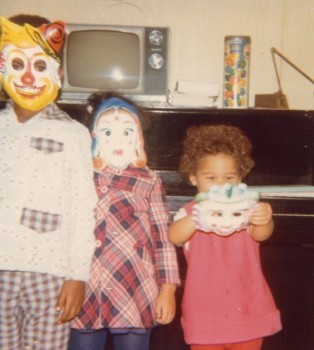 I’m losing my voice because I’ve finally caught the cold that has afflicted all my friends. After eating FOUR butter tarts yesterday, I am doing a mini-detox and these strawberries with lemon juice feel good on my raw throat. This morning I turned off the radio and listened instead to my conversation with Sandi Klein, which we taped last month. It’s always uncomfortable to hear your recorded voice, but I’m grateful for the opportunity to reflect on my writer’s life. Sandi’s fantastic podcast, Conversations with Creative Women, gives female artists the chance to talk about their evolution and influences. I don’t often talk about my older brother during interviews, but we started off with my happy childhood and that meant talking about my brother’s failed adoption. He arrived in our home on Halloween, which must have been terrifying; I was two, my sister 4, and Denzil had just turned 6. He had grown up on a small Caribbean island and found it very challenging to adjust to life in Canada. My father, who had been abused as a child, then used corporal punishment whenever my brother acted out, which only made things worse. There were a lot of silences in my family, which contributed to my decision to become a storyteller. As a child, how else do you make sense of your world? If no one gives you language to understand events, you find or create your own narratives…
I’m losing my voice because I’ve finally caught the cold that has afflicted all my friends. After eating FOUR butter tarts yesterday, I am doing a mini-detox and these strawberries with lemon juice feel good on my raw throat. This morning I turned off the radio and listened instead to my conversation with Sandi Klein, which we taped last month. It’s always uncomfortable to hear your recorded voice, but I’m grateful for the opportunity to reflect on my writer’s life. Sandi’s fantastic podcast, Conversations with Creative Women, gives female artists the chance to talk about their evolution and influences. I don’t often talk about my older brother during interviews, but we started off with my happy childhood and that meant talking about my brother’s failed adoption. He arrived in our home on Halloween, which must have been terrifying; I was two, my sister 4, and Denzil had just turned 6. He had grown up on a small Caribbean island and found it very challenging to adjust to life in Canada. My father, who had been abused as a child, then used corporal punishment whenever my brother acted out, which only made things worse. There were a lot of silences in my family, which contributed to my decision to become a storyteller. As a child, how else do you make sense of your world? If no one gives you language to understand events, you find or create your own narratives…
Heading out in search of soup. Really wanted some grey days this week but will have to write despite the bright sunshine!
October 4, 2015
blank square
 I have three blank squares on my calendar—three days with NOTHING scheduled! I *think* I could finish this neverending novel this week. I spent some time restructuring my outline last night, and eliminated one of the 7 remaining chapters by shifting its content to completed chapters that needed a bridge. In September I wrote just under 11K words—several thousand words short of my 15K-word goal, but “good enough” (as my grandpa would say). My main goal for today is to hammer out another chapter and then visit the garden without coming home with something sweet. ‘Tis the season for curling up with a cup of tea and a slice of pie, but I managed to make it out of the farmers market yesterday with three misshapen apples instead of three cider donuts. Last week it was warm and humid; I went back to wearing summer clothes and then halfway through Wednesday the weather turned. I went straight to Whole Foods and looked for something sweet to have with my tea once I got home; I found chocolate macaroons, which made me think of my grandmother who was the queen of baked goods and used to make those for us. I have one macaroon left so that will be today’s treat. I’ve already had one cup of tea and yesterday I picked up my first tin of Milo. I’ve been thinking of my ancestors lately. If I ever finish these young adult novels, I’ll go back to The Hummingbird’s Tongue and trace my love of sugar back to its origin—the trans-Atlantic slave trade, sugar plantations in the Caribbean, and all those immigrants from the British Isles who brought their recipes (and addictions) with them to the Americas. I’m tempted to bake butter tarts this week (a Canadian delicacy) but know I’d just eat them for breakfast, lunch, and dinner. My cholesterol is down six points so I’m trying to be good—or better than I normally am about baked goods. The photo above is of my great-grandmother and her parents. I don’t generally have much interest in my white ancestors except to note that most of them look dour and are known to have mistreated my grandmother for being mixed race. The folks on my maternal grandfather’s side of the family look nicer—and there’s Jenny, my Irish-Canadian great-grandmother, seated on the left. She was a big woman and so many of us inherited her genes
I have three blank squares on my calendar—three days with NOTHING scheduled! I *think* I could finish this neverending novel this week. I spent some time restructuring my outline last night, and eliminated one of the 7 remaining chapters by shifting its content to completed chapters that needed a bridge. In September I wrote just under 11K words—several thousand words short of my 15K-word goal, but “good enough” (as my grandpa would say). My main goal for today is to hammer out another chapter and then visit the garden without coming home with something sweet. ‘Tis the season for curling up with a cup of tea and a slice of pie, but I managed to make it out of the farmers market yesterday with three misshapen apples instead of three cider donuts. Last week it was warm and humid; I went back to wearing summer clothes and then halfway through Wednesday the weather turned. I went straight to Whole Foods and looked for something sweet to have with my tea once I got home; I found chocolate macaroons, which made me think of my grandmother who was the queen of baked goods and used to make those for us. I have one macaroon left so that will be today’s treat. I’ve already had one cup of tea and yesterday I picked up my first tin of Milo. I’ve been thinking of my ancestors lately. If I ever finish these young adult novels, I’ll go back to The Hummingbird’s Tongue and trace my love of sugar back to its origin—the trans-Atlantic slave trade, sugar plantations in the Caribbean, and all those immigrants from the British Isles who brought their recipes (and addictions) with them to the Americas. I’m tempted to bake butter tarts this week (a Canadian delicacy) but know I’d just eat them for breakfast, lunch, and dinner. My cholesterol is down six points so I’m trying to be good—or better than I normally am about baked goods. The photo above is of my great-grandmother and her parents. I don’t generally have much interest in my white ancestors except to note that most of them look dour and are known to have mistreated my grandmother for being mixed race. The folks on my maternal grandfather’s side of the family look nicer—and there’s Jenny, my Irish-Canadian great-grandmother, seated on the left. She was a big woman and so many of us inherited her genes 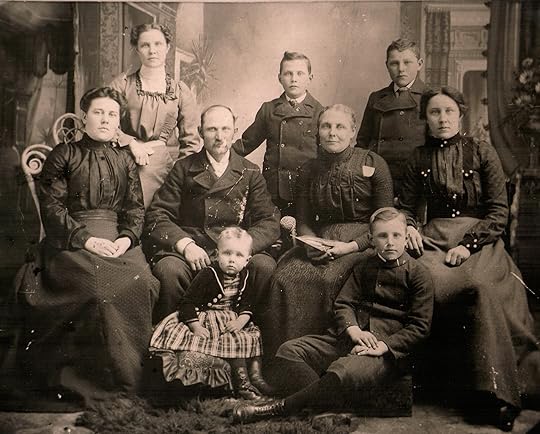 and her fondness for sweet treats. Most of my uncles and aunts are diabetic and so that’s something else I need to keep in mind as I scarf down cake every Friday. Last week Joaquin was whipping us with wind and rain but I made it over to Weeksville Heritage Center to meet with a wonderful group of students and professors from Penn State Altoona. The students are developing projects for February’s African American Read-In, and wanted to tour some sites in New York City that have defined the African American experience—Weeksville, the African Burial Ground, Seneca Village. We talked about immigration and what it means to build a home in a place where you’re not wanted…then I raced over to The Weeksville School and shared Dayshaun’s Gift and my other books with the assistant principal. I love sharing my books with kids, but there’s something special about seeing an educator’s face light up when she sees a book she likes. I’m looking forward to presenting there this fall and writing with middle grade students at my residency partner-school MS 584. There won’t be too many blank squares on my calendar this fall so let me get out of the house and over to the garden. There are too many stories I need to weave today. And tomorrow—and the day after…
and her fondness for sweet treats. Most of my uncles and aunts are diabetic and so that’s something else I need to keep in mind as I scarf down cake every Friday. Last week Joaquin was whipping us with wind and rain but I made it over to Weeksville Heritage Center to meet with a wonderful group of students and professors from Penn State Altoona. The students are developing projects for February’s African American Read-In, and wanted to tour some sites in New York City that have defined the African American experience—Weeksville, the African Burial Ground, Seneca Village. We talked about immigration and what it means to build a home in a place where you’re not wanted…then I raced over to The Weeksville School and shared Dayshaun’s Gift and my other books with the assistant principal. I love sharing my books with kids, but there’s something special about seeing an educator’s face light up when she sees a book she likes. I’m looking forward to presenting there this fall and writing with middle grade students at my residency partner-school MS 584. There won’t be too many blank squares on my calendar this fall so let me get out of the house and over to the garden. There are too many stories I need to weave today. And tomorrow—and the day after…
October 2, 2015
no hibernation
It’s October already and my fall schedule is rapidly filling up. I’ve been invited back to Weeksville Heritage Center for a second residency (woohoo!) and I’ve just lined up two new partner schools. I’m heading to Baltimore for Kidlitcon on October 10, and then I’ll be in Oakland from 10/19-21. I can’t wait to meet more indie kid lit creators and to brainstorm/hug sequoia with my “rad women” on the west coast. Then I head to London for my birthday and THEN I head to Arkansas for the first week of November. I’m really looking forward to that trip, especially my first scheduled author talk at a juvenile detention facility. The kids there are reading Ship of Souls (on sale on Amazon this month) thanks to a grant from ACTELA. I’ll spend the next day on the ASU campus, and the next day I’ll be in Blytheville. Please stop by That Bookstore in Blytheville if you’re in the vicinity at 4pm on November 3! The conference on Thursday is for educators so if you’re a teacher in AR, I hope I’ll see you there.
September 23, 2015
the Unknowns
 I’m closing in on 110,000 words and this novel is still not done! Yesterday I wrote over a thousand words, inspired in part by this article I found online about the Black baseball teams that competed in Brooklyn prior to and during the Civil War. I knew about the Negro Leagues but I didn’t realize Black men had been playing organized sports in the antebellum period. In a way, I want to shut off my brain and stop absorbing new information about the past because then I feel compelled to put it in the book. But young readers need to know about the Williamsburg Van Delkens and the Brooklyn Monitors and the Weeksville Unknowns. Games between these teams brought the community together, and proved that Black men were every bit as impressive as their white counterparts playing “America’s pastime.” The reporting at the time was full of racist caricatures (read the Brooklyn Eagle article linked to above) so I want to expose and counter that, too. On Monday I had a chance to talk about my books with DNAinfo reporter Rachel Holliday Smith (you can read her article on Dayshaun’s Gift here). She started by asking me how long I’d been writing about Weeksville and I realized I began dreaming about this free Black community back in 2001. If I ever finish this darn sequel, that will bring the total to four books about Weeksville. Later today I’ll be talking to the executive director of the Weeksville Heritage Center about hiring an illustrator for the picture book they commissioned me to write last spring. And a second residency might happen in 2016. Last time I taught a course on historical fantasy, but I think this time around I’ll teach a class on writing for children…
I’m closing in on 110,000 words and this novel is still not done! Yesterday I wrote over a thousand words, inspired in part by this article I found online about the Black baseball teams that competed in Brooklyn prior to and during the Civil War. I knew about the Negro Leagues but I didn’t realize Black men had been playing organized sports in the antebellum period. In a way, I want to shut off my brain and stop absorbing new information about the past because then I feel compelled to put it in the book. But young readers need to know about the Williamsburg Van Delkens and the Brooklyn Monitors and the Weeksville Unknowns. Games between these teams brought the community together, and proved that Black men were every bit as impressive as their white counterparts playing “America’s pastime.” The reporting at the time was full of racist caricatures (read the Brooklyn Eagle article linked to above) so I want to expose and counter that, too. On Monday I had a chance to talk about my books with DNAinfo reporter Rachel Holliday Smith (you can read her article on Dayshaun’s Gift here). She started by asking me how long I’d been writing about Weeksville and I realized I began dreaming about this free Black community back in 2001. If I ever finish this darn sequel, that will bring the total to four books about Weeksville. Later today I’ll be talking to the executive director of the Weeksville Heritage Center about hiring an illustrator for the picture book they commissioned me to write last spring. And a second residency might happen in 2016. Last time I taught a course on historical fantasy, but I think this time around I’ll teach a class on writing for children…
Off to the garden. We have brisk mornings this week…perfect for wandering and dreaming…
September 18, 2015
another new book!
FOR IMMEDIATE RELEASE:
Dayshaun’s Gift by Zetta Elliott
“The ‘trouble’ with magic, as it is represented in much of children’s literature, is that it appears to exist in realms to which only certain children belong.” ~ Zetta Elliott, “The Trouble with Magic: Conjuring the Past in New York City Parks,” Jeunesse: Young People, Texts, Cultures, Winter 2013
“The erasure of Black youth from children’s literature… functions as a kind of “symbolic annihilation.” Despite the fact that the majority of primary school children in the U.S. are now kids of color, the publishing industry continues to produce books that overwhelmingly feature white children only. The message is clear: the lives of kids of color don’t matter.” ~ Zetta Elliott, “Black Authors and Self-Publishing,” School Library Journal, 3/16/15
ABOUT THE BOOK:
Summer vacation has just begun and Dayshaun wants to spend Saturday morning playing his new video game. But Dayshaun’s mother has other plans: she volunteers at a nearby community garden and that means Dayshaun has to volunteer, too. When Dayshaun puts on his grandfather’s grubby old gardening hat, something unexpected happens—the hands of time turn backward and Dayshaun finds himself in the free Black community of Weeksville during the summer of 1863! While helping the survivors of the New York City Draft Riots, Dayshaun meets a frail old man who entrusts him with a precious family heirloom. But will this gift help Dayshaun find his way back to the 21st century? Book #2 in the City Kids series.
DAYSHAUN’S GIFT takes readers back in time to the sweltering summer of 1863 when New York City exploded—not for the first time—with racial tension. Dayshaun learns about the importance of urban farming and self-sufficient communities when refugees from the draft riots seek sanctuary in the free Black community of Weeksville. This story blends the magic of time travel with local African American history, introducing young readers to neglected historical figures like Susan Smith (the first African American woman doctor in NY State). In the era of Black Lives Matter, DAYSHAUN’S GIFT offers children important context for understanding urban uprisings, the ongoing struggle for social justice, and the universal desire to belong.
ABOUT THE AUTHOR:
Zetta Elliott’s first picture book, BIRD, won Lee & Low’s New Voices honor award and was published in 2008; it was named an ALA Notable Book, Best of the Year by Kirkus, and went on to win the Paterson Prize for Poetry as well. Elliott’s next two books, both historical fantasy novels, were published by Skyscape. A WISH AFTER MIDNIGHT (2010) is a time-travel novel set in Civil War-era Brooklyn. SHIP OF SOULS (2012) blends magic and Brooklyn’s Revolutionary War history; Booklist named it a Top Ten Sci-Fi/Fantasy title.
Zetta Elliott has published several illustrated picture books and middle grade novels under her own Rosetta Press imprint; ROOM IN MY HEART (2014) was named a Best Children’s Book of the Year by Bank Street College of Education, and THE PHOENIX ON BARKLEY STREET (City Kids Book #1) was selected by the Children’s Defense Fund for their 2014 summer literacy program.
Zetta Elliott is also a scholar of children’s literature and recently won the Children’s Literature Association’s Article Award for her essay “The Trouble with Magic: Conjuring the Past in New York City Parks” (PDF available upon request). She has worked with urban youth for over 25 years, and was a Black Studies professor for close to a decade. For the past five years Elliott has spoken often and openly about the need for greater diversity in publishing; her latest essay was for School Library Journal.
Born and raised in Canada, Zetta Elliott has lived in the US for over twenty years. She earned her PhD in American Studies from NYU in 2003. Her poetry has been published in several anthologies, and her plays have been staged in NYC, Chicago, and Cleveland. Elliott served as the inaugural writer-in-residence at Weeksville Heritage Center in the spring of 2015. She currently lives in Brooklyn.
ABOUT ROSETTA PRESS:
Rosetta Press is committed to publishing books that reveal, explore, and foster a Black feminist vision of the world. Rosetta Press publishes books for children with the following objectives:
To generate culturally relevant stories that center children who have been marginalized, misrepresented, and/or rendered invisible in children’s literature.
To produce affordable, high-quality books so that families—regardless of income—can build home libraries that will enhance their children’s academic success.
To produce a steady supply of compelling, diverse stories that will nourish the imagination and excite even reluctant readers.
Like all Rosetta Press titles, DAYSHAUN’S GIFT is available at zettaelliott.com, Amazon, Baker & Taylor, Ingram, and bookstores everywhere, including nonprofit Teaching for Change. E-book is available in the Kindle Store.
###
DAYSHAUN’S GIFT
By Zetta Elliott
Rosetta Press
Publication Date: September 20, 2015
Paperback; $7.00; 88 Pages
Age 8+
September 16, 2015
something new
![Pageflex Persona [document: PRS0000038_00053]](https://i.gr-assets.com/images/S/compressed.photo.goodreads.com/hostedimages/1442456151i/16237389.jpg) Somehow, despite consuming a pint of ice cream yesterday, I’ve managed to reach my “target weight.” I’m feeling a little stressed out this week and since I was feeling blue earlier this month, I’ve been careful to keep up with my exercise routine. I run every other day but after yesterday’s ice cream lapse, I went again today thanks to a friend who texted me to meet her at the park. Today’s craving? Chocolate. When it comes to weight, I generally take one step forward and two steps back; on Friday I’m having my cholesterol tested again so chocolate after ice cream (and pumpkin bread on Tuesday) probably isn’t a good idea. But it WILL happen if I write 500 words this afternoon. My Fitbit battery is about to die, so I’ll add a few thousand steps on my way to the hardware store and grab something sweet on the way home. It’s about balance, right? I’ve been feeling off kilter lately because I started a new teaching job on Saturday and then socialized quite a bit on Sunday, and then tried to wrap up three new book projects while maintaining my 500 words per day quota. The illustrated middle-grade novel has just been submitted for review and I hope to have a copy in my hands by Monday. Final art came in from my illustrators in London and Hong Kong, so my designer is busy putting those picture books together, too. I wonder what it will be like once the new books are done and I have nothing to distract me from this novel-in-progress…
Somehow, despite consuming a pint of ice cream yesterday, I’ve managed to reach my “target weight.” I’m feeling a little stressed out this week and since I was feeling blue earlier this month, I’ve been careful to keep up with my exercise routine. I run every other day but after yesterday’s ice cream lapse, I went again today thanks to a friend who texted me to meet her at the park. Today’s craving? Chocolate. When it comes to weight, I generally take one step forward and two steps back; on Friday I’m having my cholesterol tested again so chocolate after ice cream (and pumpkin bread on Tuesday) probably isn’t a good idea. But it WILL happen if I write 500 words this afternoon. My Fitbit battery is about to die, so I’ll add a few thousand steps on my way to the hardware store and grab something sweet on the way home. It’s about balance, right? I’ve been feeling off kilter lately because I started a new teaching job on Saturday and then socialized quite a bit on Sunday, and then tried to wrap up three new book projects while maintaining my 500 words per day quota. The illustrated middle-grade novel has just been submitted for review and I hope to have a copy in my hands by Monday. Final art came in from my illustrators in London and Hong Kong, so my designer is busy putting those picture books together, too. I wonder what it will be like once the new books are done and I have nothing to distract me from this novel-in-progress…
Something else that’s new is an exciting blog, Reading While White, developed by a group of radical librarians (several of whom I am proud to call “friend”). The first post by Allie Jane Bruce should make clear why this is a very necessary endeavor:
“But if we White people talk about racism as if we are not part of the equation, we are the problem. We have a responsibility not just to boost marginalized voices as much as we can, but also to examine ourselves and our Whiteness. And we must create all-White spaces in which we can do this work without burdening non-White communities. People of color and First/Native Nations have enough work to do in analyzing how racism has impacted their lives. To ask them to also educate us on our Whiteness is White privilege in the extreme.”
Diversity in children’s literature always ends up being a panel of marginalized writers talking about their struggle to get published and/or stocked in bookstores and/or taught in schools. But the truth is, the children’s literature community is dominated by one group: white women. They make up the majority of teachers, librarians, and editors in this country. So if we hope to address the inequality within our community, we must have support from those who are largely responsible for the disparities that exist. I have no problem whatsoever with white women librarians creating a space where other white people can talk about privilege and bias and power—and guilt and shame and resentment and anxiety and all the other emotions that powerful, privileged people too often try to deny or simply don’t know how/where to talk about. I’ve already written one short essay about white women and white supremacy in publishing and would like to write another, but I know that my voice will never carry as much weight as the voices of other white women. So I commend these allies and offer my full support—and urge you to check out their site.

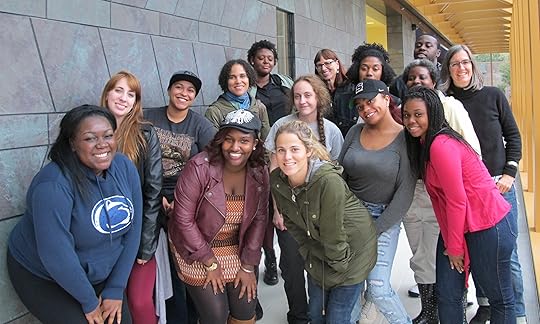
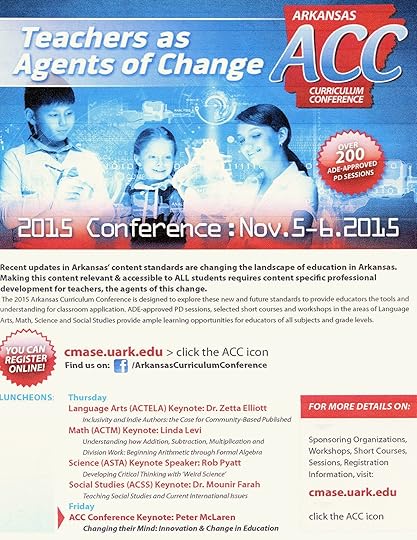
![Pageflex Persona [document: PRS0000038_00053]](https://i.gr-assets.com/images/S/compressed.photo.goodreads.com/hostedimages/1442720655i/16272769._SY540_.jpg)


